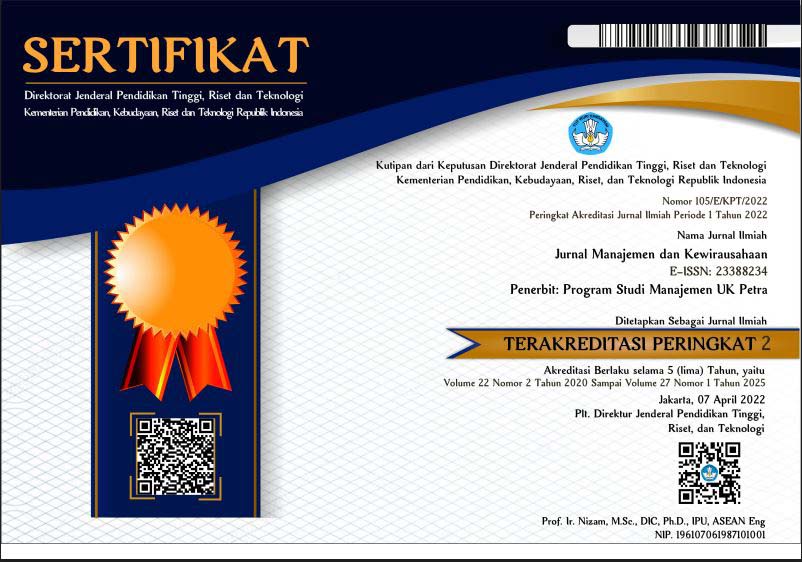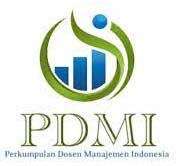THE ROLE OF MARKETING AMBIDEXTERITY TO UPSCALING SME’S BUSINESS PERFORMANCE
DOI:
https://doi.org/10.9744/jmk.27.1.43-52Keywords:
Business performance, market-driven, market-driving, ambidexterity, SMEsAbstract
This study aims to examine entrepreneurship orientation, online marketing capability, and marketing ambidexterity on fashion business performance in SMEs in Central Java. A total of 230 fashion business owners selected using a simple random sampling technique were involved in this study. Data were analyzed using SEM-Amos. The study's results indicated that marketing ambidexterity represented by market-driving orientation was significant to fashion business performance. In contrast, market-driven orientation was not proven to influence business performance. In addition, marketing ambidexterity was influenced by online marketing capability. Furthermore, the other factors that could improve SME fashion business performance are entrepreneurship orientation and online marketing capability. Although entrepreneurship orientation was significant toward business performance, it did not influence online marketing capability. The implication of this study is that SME businesses should take a business approach that focuses on understanding and fulfilling customer needs and desires by optimizing online marketing capabilities and paying attention to entrepreneurship orientation.
References
Abrokwah-Larbi, K., & Awuku-Larbi, Y. (2023). The impact of artificial intelligence in marketing on the performance of business organizations: evidence from SMEs in an emerging economy. Journal of Entrepreneurship in Emerging Eco-nomies, February. https://doi.org/10.1108/JEEE-07-2022-0207
Adiwijaya, K., Wahyuni, S., Gayatri, G., & Mussry, J. S. (2020). Does marketing ambidexterity boost marketing performance? empirical evidence in Indonesia’s consumer goods. Journal of Global Marketing, 33(4), 266–288. https://doi.org/10.1080/08911762.2019.1696438
Ali, S., Wu, W., & Ali, S. (2022). Adaptive marketing capability and product innovations: the role of market ambidexterity and transformational leadership (evidence from Pakistani manufacturing industry). European Journal of Innovation Management, 25(4), 1056–1091. https://doi.org/10.1108/EJIM-12-2020-0520
Apasrawirote, D., Yawised, K., & Muneesawang, P. (2022). Digital marketing capability: the mystery of business capabilities. Marketing Intelligence and Planning, 40(4), 477–496. https://doi.org/10.1108/MIP-11-2021-0399
Ashraf, M. A. (2023). Comprehending the intention to use branchless banking by rural people during the corona pandemic: evidence from Bangladesh. Journal of Financial Services Marketing, 28(1), 99–116. https://doi.org/10.1057/s41264-021-00136-7
Barney, J. B., Ketchen, D. J., & Wright, M. (2011). The future of resource-based theory: Revitalization or decline? Journal of Management, 37(5), 1299–1315. https://doi.org/10.1177/0149206310391805
Chang, Y. Y., & Hughes, M. (2012). Drivers of innovation ambidexterity in small- to medium-sized firms. European Management Journal, 30(1), 1–17. https://doi.org/10.1016/j.emj.2011.08.003
Chinakidzwa, M., & Phiri, M. (2020). Impact of digital marketing capabilities on market performance of small to medium enterprise agro-processors in Harare, Zimbabwe. Business: Theory and Practice, 21(2), 746–757. https://doi.org/10.3846/btp.2020.12149
Danzen, O. B. (2022). Measuring the level of digital marketing capabilities, digital marketing strategies and challenges and issues of smes in adopting digital marketing. Journal of Marketing Advances and Practices (JMAP), 4(1), 79–96.
Farida, I., & Setiawan, D. (2022). Business strategies and competitive advantage: the role of performance and innovation. Journal of Open Innovation: Technology, Market, and Complexity, 8(3), 163. https://doi.org/10.3390/joitmc8030163
Fatonah, S., & Haryanto, A. T. (2022). Exploring market orientation, product innovation and competitive advantage to enhance the performance of smes under uncertain events. Uncertain Supply Chain Management, 10(1), 161–168. https://doi.org/10.5267/j.uscm.2021.9.011
Hadiyati, E., Mulyono, S., & Gunadi. (2024). Digital marketing as a determinant variable for improving the business performance. Innovative Marketing, 20(3), 28–41. https://doi.org/10.21511/im.20(3).2024.03
Hair, J. F., Risher, J. J., Sarstedt, M., & Ringle, C. M. (2019). When to use and how to report the results of PLS-SEM. European Business Review, 31(1), 2–24. https://doi.org/10.1108/EBR-11-2018-0203
He, X., & Wei, Y. (2011). Linking market orientation to international market selection and international performance. International Business Review, 20(5), 535–546. https://doi.org/10.1016/j.ibusrev.2010.10.003.
Herhausen, D., Miočević, D., Morgan, R. E., & Kleijnen, M. H. P. (2020). The digital marketing capabilities gap: empirical evidence, managerial shortcomings, and future research streams. In Industrial Marketing Management (Vol. 90).
Ho, H., Osiyevskyy, O., Agarwal, J., & Reza, S. (2020). Does ambidexterity in marketing pay off? The role of absorptive capacity. Journal of Business Research, 110(December 2019), 65–79. https://doi.org/10.1016/j.jbusres.2019.12.050
Joensuu-Salo, S., Sorama, K., Viljamaa, A., & Varamäki, E. (2018). Firm performance among internationalized smes: The interplay of market orientation, marketing capability and digitalization. Administrative Sciences, 8(3). https://doi.org/10.3390/admsci8030031
Khan, H., Mavondo, F., & Zhou, N. (2022). Integration of outside-in and inside-out entrepreneurial marketing capabilities, marketing agility and resources for entrepreneurial firm performance. International Journal of Entrepreneurial Behavior & Research. https://doi.org/10.1108/IJEBR-02-2022-0193
Kowalik, I., & Pleśniak, A. (2022). Marketing determinants of innovation ambidexterity in small and medium‐sized manufacturers. Entrepreneurial Business and Economics Review, 10(2), 163–185. https://doi.org/10.15678/EBER.2022.100210
Liu, J., Wang, C., Zhang, T., & Qiao, H. (2023). Delineating the effects of social media marketing activities on generation z travel behaviors. Journal of Travel Research, 62(5), 1140–1158. https://doi.org/10.1177/00472875221106394
Mathews, S. W., Maruyama, M., Sakurai, Y., Perks, K. J., & Sok, P. (2019). Risk perceptions in Japanese SMEs: the role of Internet marketing capabilities in firm performance. Journal of Strategic Marketing, 27(7), 599–611. https://doi.org/10.1080/0965254X.2018.1464048
Mehrabi, H., Coviello, N., & Ranaweera, C. (2019). Ambidextrous marketing capabilities and performance: How and when entrepreneurial orientation makes a difference. Industrial Marketing Management, 77(January 2018), 129–142. https://doi.org/10.1016/j.indmarman.2018.11.014
Müller, J. M., Buliga, O., & Voigt, K. I. (2020). The role of absorptive capacity and innovation strategy in the design of industry 4.0 business Models-A comparison between SMEs and large enterprises. European Management Journal. https://doi.org/10.1016/j.emj.2020.01.002
Mulyana, M., Nurhayati, T., & Putri, E. R. P. (2024). Improvement of marketing performance: Role of market sensing, digital marketing, and value creation ambidexterity. Contaduria y Admini-stracion, 69(2), 235–259. https://doi.org/10.22201/fca.24488410e.2024.5017
Munir, A. R., Kadir, N., Umar, F., & Lyas, G. B. (2023). The impact of digital marketing and brand articulating capability for enhancing marketing capability. International Journal of Data and Network Science, 7(1), 65–72. https://doi.org/10.5267/j.ijdns.2022.12.005
Permana, E., Poerwoko, B., Widyastuti, S., & Rachbini, W. (2019). Digital capability and innovation strategy to develop the performance and competitive advantages of fashion Smes in Jakarta, Indonesia. International Journal of Managerial Studies and Research, 7(11), 5–15. https://doi.org/10.20431/2349-0349.0711002
Purwanti, I., Lailyningsih, D. R. N., & Suyanto, U. Y. (2022). Digital marketing capability and MSMEs performance: understanding the moderating role of environmental dynamism. Jurnal Manajemen Teori Dan Terapan | Journal of Theory and Applied Management, 15(3), 433–448. https://doi.org/10.20473/jmtt.v15i3.39238
Qureshi, M. S., Aziz, N., & Mian, S. A. (2017). How marketing capabilities shape entrepreneurial firm’s performance? Evidence from new technology based firms in turkey. Journal of Global Entrepreneurship Research, 7(1). https://doi.org/10.1186/s40497-017-0071-5
Salah, O. H., & Ayyash, M. M. (2024). E-commerce adoption by SMEs and its effect on marketing performance: An extended of TOE framework with ai integration, innovation culture, and customer tech-savviness. Journal of Open Innovation: Technology, Market, and Complexity, 10(1), 100183. https://doi.org/10.1016/j.joitmc.2023.100183
Schindehutte, M., Morris, M. H., & Kocak, A. (2008). Understanding market-driving behavior : the role of entrepreneurship the MO of a company. 46(1), 4–26.
Setyaningrum, R. P., Kholid, M. N., & Susilo, P. (2023). Sustainable SMEs performance and green competitive advantage: the role of green creativity, business independence and green IT empowerment. Sustainability (Switzerland), 15(15). https://doi.org/10.3390/su151512096
Shen, H., & Wall, G. (2021). Social media, space and leisure in small cities. Asia Pacific Journal of Tourism Research, 26(2), 73–80. https://doi.org/10.1080/10941665.2020.1859057
Tolstoy, D., Nordman, E. R., & Vu, U. (2022). The indirect effect of online marketing capabilities on the international performance of e-commerce SMEs. International Business Review, 31(3). https://doi.org/10.1016/j.ibusrev.2021.101946
Wang, F. (2020). Digital marketing capabilities in international firms: a relational perspective. International Marketing Review, 37(3), 559–577. https://doi.org/10.1108/IMR-04-2018-0128
Zahara, Z., Ikhsan, Santi, I. N., & Farid. (2023). Entrepreneurial marketing and marketing performance through digital marketing capabilities of SMEs in post-pandemic recovery. Cogent Business and Management, 10(2). https://doi.org/10.1080/23311975.2023.2204592
Zahoor, N., & Lew, Y. K. (2023). Enhancing international marketing capability and export performance of emerging market SMEs in crises: strategic flexibility and digital technologies. International Marketing Review, 40(5), 1158–1187. https://doi.org/10.1108/IMR-12-2021-0350
Zehir, C., Köle, M., & Yıldız, H. (2015). The mediating role of innovation capability on market orientation and export performance: an imple-mentation on SMEs in Turkey. Procedia - Social and Behavioral Sciences, 207, 700–708. https://doi.org/10.1016/j.sbspro.2015.10.141
Zhou, L., Peng, M. Y. P., Shao, L., Yen, H. Y., Lin, K. H., & Anser, M. K. (2021). Ambidexterity in social capital, dynamic capability, and SMEs’ performance: quadratic effect of dynamic capability and moderating role of market orientation. Frontiers in Psychology, 11(February), 1–15. https://doi.org/10.3389/fpsyg.2020.584969
Downloads
Published
How to Cite
Issue
Section
License
Copyright (c) 2025 Alya Nisa Ramadani, Sulis Riptiono, Sigit Wibawanto

This work is licensed under a Creative Commons Attribution 4.0 International License.
Authors who publish on this journal agree to the following terms:
- Authors retain copyright and grant the journal right of first publication with the work simultaneously licensed under a Creative Commons Attribution License that allows others to share the work with an acknowledgement of the work's authorship and initial publication in this journal.
- Authors are able to enter into separate, additional contractual arrangements for the non-exclusive distribution of the journal's published version of the work (e.g., post it to an institutional repository or publish it in a book), with an acknowledgement of its initial publication in this journal.
- Authors are permitted and encouraged to post their work online (e.g., in institutional repositories or on their website) prior to and during the submission process, as it can lead to productive exchanges, as well as earlier and greater citation of published work (See The Effect of Open Access).


















